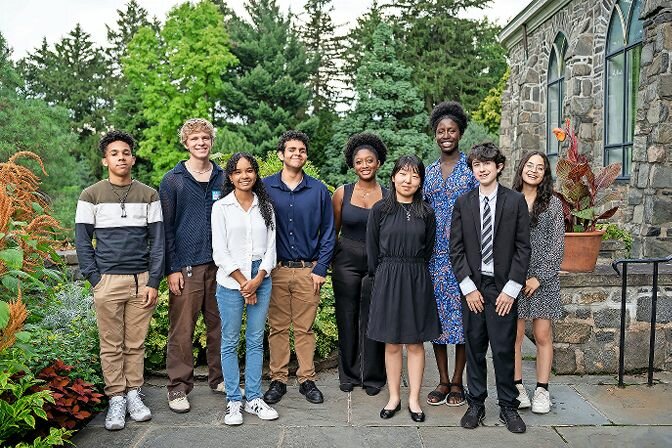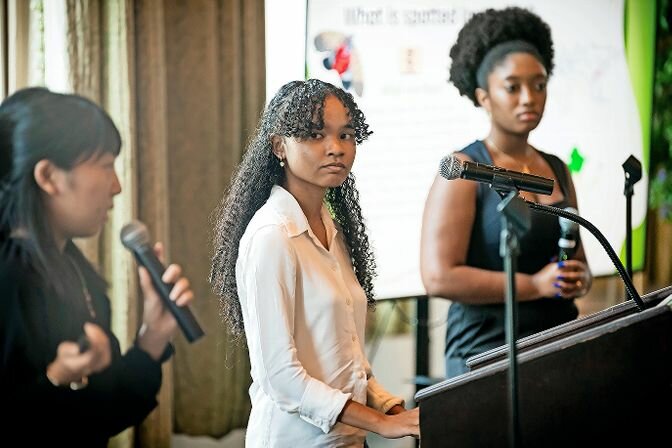Wave Hill's WERMs prove their hypothesis on rooftops of New York City
Wave Hill provides 14-month internships for students to take a deep dive into urban ecology
Green houses and arthropods played a significant role in three Wave Hill intern teens’ lives this past year.
So, if there were more arthropods would that increase vegetation such as shrubs and small plants?
Yes, according to the hypothesis developed by Nana Adwoa Agyemang, Oscar Smith and Amelia Tejeda, who spent 14 months at Wave Hill’s Woodland Ecology Research Mentorship program. During the final phase of the internship they found support for their hypothesis.
In preparation for their answer, the WERMS, as they are called, went to four different green roofs around the city to do hands-on fieldwork.
Agyemang’s favorite green roof was the Brooklyn Grange, which has a three-acre green house. “It was a very awesome experience because we got to see what a large farm scale looks like in the urban space,” she said.
In total there were nine WERMS who conducted research, which was split into three groups that had different projects.
One group also looked at the notorious spotted lanternflies — insects that damage trees and feed of the sap of plants in greater Riverdale. Another researched beech leaf disease, which is a relatively new disease that affects beech trees.
However, all good things come to an end which was bittersweet for most students and nerve wracking for others. The nine students celebrated their graduation by presenting their project on Aug. 16
“We definitely prepared a lot so it’s kind of surreal, seeing everybody sitting there,” Agyemang said. “Everybody was also looking forward to what we had to say.”
Over 75 percent of the participants come from Title 1 schools — funding for financial assistance with schools of high number of low-income families, primarily in the Bronx. But not Agyemang, as she is a homeschooled junior in Manhattan.
Being homeschooled “is very helpful because it allows me to have more free time and more time to pursue my passions and things that I’m more interested in,” she said.
Agyemang express this internship would not be possible if she attended traditional school. She lived in Atlanta before moving to New York, where she applied for internships because she was “curious” about them.
The 16-year-old had thoughts about attending in-person classes.
However, she realized it would be too time-consuming, and now she has flexibility.
The other interns are about the same age as Agyemang. Teens must be at least 16 the second summer to participate in the New York City Summer Youth Employment Program, which includes Wave Hill.
The program is meant to give students a chance to participate in STEM fieldwork, research, or extracurricular activities that some might not have the opportunity to participate in within their school or anywhere else.
That’s what Tim Wheeler, the manager of youth programs, said. January will mark one year for him working at Wave Hill.
“I hire professors to teach the three classes and depending on which program the interns are in, they’ll either get credit for one class or three by the end of the program,” he said.
The organization’s educators have developed three college-level courses — through the partnership with the College of Mount Saint Vincent in Riverdale:
• Restoration of New York city’s natural areas
• Mapping New York city’s urban environment
• Introduction to science research
“It’s great if we have students that are very high achievers in their classes, but I think it’s also great to have students in a normal classroom setting,” he said. “Maybe they don’t thrive — but they can come to learn and grow with us to be in this different setting.”
WERM is one of the two internships that falls under the youth programs umbrella at Wave Hill.
The other is the Forest Project — one of the oldest urban woodland conservation programs for the youth in the United States.
It celebrated its 40th anniversary last year.
Each year, about 15 teens work 25 hours each week working to restore the organization’s woodlands.
Both are designed to allow students to gain hands-on experience at Wave Hill and train young adults in the Bronx to do that fieldwork.
“It’s incredibly important for them to have the opportunity,” Wheeler said. “Maybe they know already that they want to go into a STEM career, or maybe they are just interested in it.”
Agyemang is still deciding what she wants to do for a career, but she intends to continue down a career path of what WERM gave her.
Her roots trace back to Ghana, influencing her to create an organization that helps and educates her people back home. Some of her ideas include urban ecology and how best to use the space in Ghana for environmental reasons.
The difference between the U.S. and Ghana in urban ecology is that Africa serves as a tropical climate whereas New York sometimes has a humid subtropical climate.
“I never thought that I would be a part of this because I applied three days after the deadline, so I wasn’t sure that I was going to get in,” Agyemang said. “I was definitely amazed that I was able to get in.”









